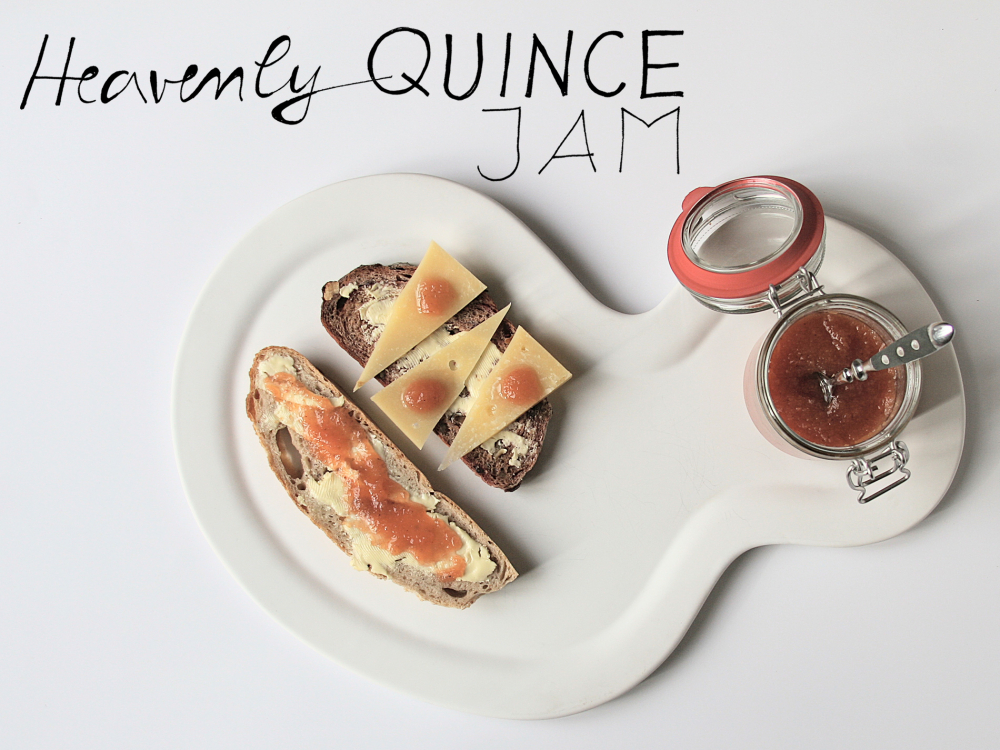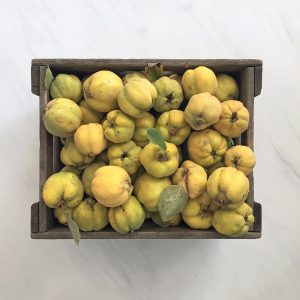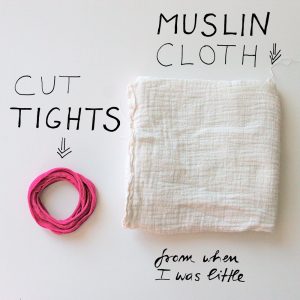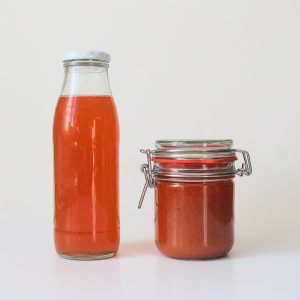The other day I took some of my home made quince jam to a breakfast with mainly international people. It turned out that most of them had never heard of quinces let alone knew what they taste like. There were lots of happy mmh-sounds and delightfully raised eyebrows so I thought I would introduce you to one of my family’s favourite tastes: quince. The fruit works as a breakfast jam on bread or rolls and is also amazing on cheese with or without bread. The reddish bread on the picture is from my favourite baker’s in Munich: beetroot bread with nuts and cranberries and in combination with this mature cheese from Italy and the quince jam the taste is incredible! I use the jam or paste for cooking, for example for roast duck or even our xmas goose. The juice I like best mixed with one part of cloudy apple juice and two parts of sparkling water.
2kg quinces
around 1.5kg regular sugar
optional: a vanilla pod halved or, which I find easier and cheaper, a small bag of real vanilla sugar
Cooking time: 40 minutes
METHOD
Rub off the fluff with a kitchen towel and wash the quinces. The less fluff they carry when you buy them the older they are. Then cut them into pieces. I have a special way doing it. Why? For two reasons: first of all quinces are really tough and secondly I don’t want small dark bits of the pips in my jam for visual reasons. Speaking of the pips: they are highly poisonous when raw. But don’t panic, when heated up the amygdalin, which would be processed to hydrocyanic acid in your guts will be destroyed. And we need to work with the core and its pips as they contain pectin which is responsible for the thickening of the jam.
For cutting, use a sharp chef’s knife and make sure your board is secured. For best stability, place the quince bottom up on the board. Cut off one side, turn the quince 90 degrees, cut off the next side and so on until you have four meaty bits and the core. With the knife I slightly incise the core in the middle and break it into two to check if it is for some reason wormy. If it is fine put everything into a big pan and add water until just covered. Boil until soft for about 40 minutes.
Let cool for a bit and pass everything through a food mill. A fine meshed sieve would also work but it is a REAL pain. Chuck what remains in the food mill.
Then I do three things with it:
Juice
For juice I put a muslin cloth over a pan and fix it with a piece of cut stocking – this fits perfectly (and also makes my standard hair bobble if not used for this kind of stuff). Pour your quince mash into it and leave for a while or over night. I then put the juice that came though into standard cream glass bottles, that have been sterilised (the lid boiled in vinegar water for 5 minutes, the glass put in the oven for 10 minutes at 180°C). This will keep in the fridge for a few days.
To make the juice last for a couple of years, I place my filled and tightly-closed bottles without touching each other on a dripping pan or casserole filled with about an inch of room temperature warm water – it has to have the same temperature as your liquid to avoid tension – and put them into the oven. Set the heat to 90°C and wait for the liquid to start bubbling slightly, this will take around half an hour. Then switch off the oven and leave your bottles inside for another 30 minutes. Handle with care when taking them out!
Paste
For the paste I use what was left in the muslin cloth. Weigh it and put in it in a pan. Add 60% of its weight in sugar and cook everything on a medium heat until very thick / the bottom of the pan remains visible for a few seconds when stirring. That could take up to an hour. Pour it into a cake tin or small casserole and let dry for a week or stick it into the oven at 80°C and dry for two hours or so. Cut it into handleable bits and wrap in into parchment paper and store at a cool, dry and dark place. It should last several weeks but I usually put it into the freezer to be extra safe and make it last even longer.
Jam
For the jam I use the original quince mash. Weigh it and put in it in a pan. Add 60% of its weight in sugar and cook everything on a medium heat for at least 30 minutes. The longer you cook it, the thicker the texture. Best is to test if it has the perfect texture: keep a small plate in your fridge and put some of your jam onto it when you think it is ready. Put the plate back into the fridge and wait until completely cool. If you hold the plate up and the jam just isn’t running down it is perfect. Put your hot jam in sterilised mason jars (the lid boiled in vinegar water for 5 minutes, the jar put in the oven for 10 minutes at 180°C), close them tightly and put them upside down for 10 minutes for the heat of the jam to kill every germ in every corner.
If you are using clip lid jars like I do, put the hot jam into the sterilised jars (the rubber ring boiled in vinegar water for 5 minutes, the jar put in the oven for 10 minutes at 180°C). Then place them without touching each other on a dripping pan or casserole filled with about an inch of hot water – it has to have the same temperature as your jam to avoid tension – and put them into the oven. Set the heat to 90°C and let it sit for half an hour. Then switch off the oven and leave your jars inside for another 30 minutes. Handle with care when taking them out!
Extra tricks
Alternatively to buying quinces from a shop or market you could also try digital sales platforms and purchase them from a private grower — as suggested by a friend with whom I share a love for quinces, thanks Esther! A lot of tree owners don’t know what to do with quinces and sell them cheap as chips. Use brown sugar for a richer flavour and a darker colour. If for some reason your jam doesn’t seem to thicken as hoped add the juice of one freshly squeezed lemon as this will give it an extra dose of pectin.




